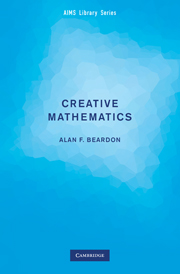13 - Problem I: Solution
Published online by Cambridge University Press: 16 May 2024
Summary
We can systematically list all (unordered) Diophantine pairs by writing down all factorisations of the numbers n2 − 1, where n = 2, 3, … .
This list begins as follows:
(1, 3), (1, 8), (2, 4), (1, 15), (3, 5) (1, 24), (2, 12), (3, 8), (4, 6), (1, 35), …
Given any positive integer p, we have p(p + 2) + 1 = (1 + p)2 so that (p, p + 2) is a Diophantine pair. Thus every positive integer occurs in some Diophantine pair.
Now consider Diophantine triples: you should try to find some of these by using a computer. In fact, there is a systematic way to pass from a Diophantine pair (a, b) to a Diophantine triple (a, b, c), and so construct infinitely many Diophantine triples.
Theorem If (a, b) is a Diophantine pair with ab + 1 = q2 then (a, b, c) is a Diophantine triple, where c = a + b + 2q.
• Use a computer to check this for a number of cases. Then give an algebraic proof. Show, however, that not every Diophantine triple arises in this way.
Here is another way to try to find Diophantine triples.
• Suppose that a and b are coprime and that ab + 1 = q2. Show that there is someDiophantine triple (a, b, c) if and only if there are integer solutions X and Y to the Diophantine equation bX2 + a = aY2 + b.
You can also use this result (whether you have proved it or not) with a computer to produce many Diophantine triples. For example, try to find (many) values of p, q and r such that the triples (1, 3, p), (1, 8, q) and (3, 8, r) are Diophantine triples.
A Diophantine 4–tuple is a set of four integers a1, a2, a3, a4 such that if i = j then aiaj + 1 is a square of an integer.
• Find some Diophantine 4–tuples.
- Type
- Chapter
- Information
- Creative MathematicsA Gateway to Research, pp. 61 - 62Publisher: Cambridge University PressPrint publication year: 2009

